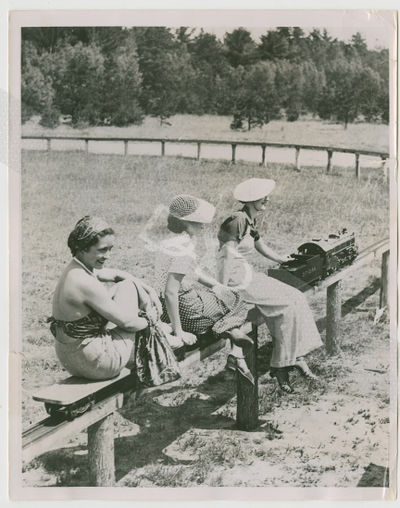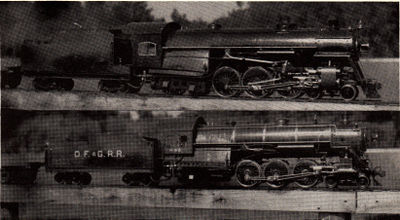Eugene H. Stevens
1936 Meet
Preparing for Miniature Locomotive Meet
Out for a trail run preparatory to being entered in the Live Steamers Annual Model Meet to be held at Oxford, Maine, June 7, is this model which was built by Eugene H. Stevens, of the Maine Highway Police. It is valued at $2,500, took 1,300 hours to build, and will haul a load of 1,900 pounds. it burns ordinary soft coal and is an exact model in every way of a real locomotive. Eleanor Wheelright, of Wilton, Gerry Mann, of West Paris, and Irmalea Fehou, of Lewiston are enjoying the tour around the quarter-mile track where the meet will be held with 30 entrants from various sections of the country. 28 May 1936
Wandering Locomotive Book
The following excerpt from the Wandering Locomotive Books was reprinted in The North American Live Steamer, Volume 1 Number 6, 1956 in the column by Charles A. Purinton.
Eugene H. Stevens, March 1938
To My Friends Who Refuse To Bother With An Electric Driven Engine: Here I am with my first look at the Wandering Locomotive Books of the Brother of Live Steamers, having spent some years of my life poking coal into various kinds of engines that have a drag behind them, trying to keep the hand on the pin on that old fog indicator and having the smell of sulphur and burning coal in my system. I cannot jump right out of that and run an engine run with a motor or a spring, so I am a dyed in the wool live steamer, so much for the reason for the itch to voluntarily assume the life of grease and cinders.
These two engines, photographs No. 3 and 4 are my fifth and sixth locomotives. These were built without drawings and using a sense of proportion only. I wish to call attention to the boilers made from 3/16 inch or 1/4 inch by six inches in diameter steel tubing. It is sawed half way through at length of firebox and this is cut longitudinally and the halves opened out to make the outside of the firebox. The water legs are made of 1/4 inch plate welded, and all tubes are welded in at both front and rear, fitted with eight arch tubes 7/16 inch diameter and all boilers have had a test of 400 pounds per square inch without a leak, running pressure 100 pounds per square inch, but had to be cut down fro they were so slippery they would not pull your hat off. The No. 462 engine was built in 1936, cylinders 1-5/8 by 1-3/4 inch stroke, using link motion, 7/16 inch valve travel. The other engine has the Baker valve gear. The water supply by injector and eccentric pump on driving axle.
Of course, after an engine is built the itch is just starting. It is a great source of pleasure to know how she will act under a load on a track and under running conditions. Will she keep up steam, will the fire burn even, will she keep the water up? That means everyone wants a chance to keep his engine running, and that is exactly the case, using the circular track at Oxford, Maine.
This track provides a continuous track of 1/5 of a mile. All gadgets can be given a running test. If a running test appeals to you, try to come along to Oxford, Maine and bring your engine and meet the gang. 2-1/2 inch and 3-1/2 inch gauge track. The track is mounted on posts so track is about 32 inches high. You ride a flat car behind your engine and blow your whistle and cuss the train dispatcher to dig the cinders our of your ears, just like a regular railroad. Come to the next meet if possible. I have now an Atlantic type engine about 3/4 complete, but expect to have this ready for the next meet. This engine has 1-7/16 inch bore and 2 inch stroke with six inch driving wheels. There were six engi9nes under steam at our meeting and at another about ten engines under steam, all day long and some the next day. Engines from Boston and Montreal have been there.
An effort will be made to let everyone know in good time so you can make plans to be there. Free coal, water, oil and the coal is not plain ballaet which railway companies give their men to burn. Let everybody see everybody at the meet, generally in August each year.

